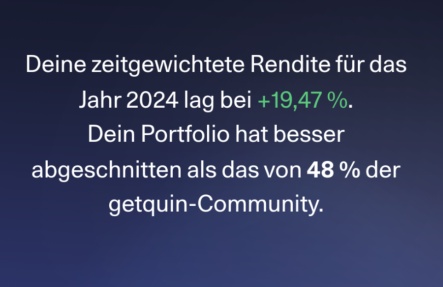Hello everyone!
My parents are in the process of selling my grandparents' house. It will probably fetch around €275,000. My parents will soon both be 60 years old.
They had initially considered buying another property nearby. But they have moved away again. The lack of flexibility and the time and risk involved with tenants put them off.
I also told them more about investing in the stock market. They were very open and interested, even though they said they had an unfounded fear of shares etc.
Now my question to you. What is the best way to invest the money? I think dividends would be very nice as my parents like the passive income like from a property. But it should also be very well diversified across countries and sectors.
I personally have developed 2 solutions. You can give your opinion as to whether you think the solutions are good or, of course, if you have completely different ideas.
1. the ETF solution
15% $XEOD (+0.01%) Call money ETF. Div. 1.9%
15% $TDIV (+0.39%) VanEck Divi Leaders. Div 3.5%
10% $TRET (+0.17%) Global Real Estate. Div. 3.7%
7,5% $VHYL (+0.09%) Allworld High Div Yi. Div 3.1%
7,5% $PEH (+0.34%) FTSE RAFI EM. Div 3.9%
5% $EWG2 (+0.8%) Gold
5% $SEDY (+0.02%) iShares EM Dividend. Div 8.0%
5% $JEGP (+0.16%) JPM Global Equity Inc Div 7.1%
5% $EEI (+0.22%) WisTree Europ Equity Inc Div 6.3%
5% $IHYG (+0.12%) High Yield Bond. Div 6.1%
5% $EXXW (+0.41%) AsiaPac Select Div50 Div 5.5%
15% Rest German Divi Shares approx. div 2.5%
=100% with 3.7% dividend.
275k ×3,7% = 10.175€
With full taxation 27.99% = 7327€
On average per month: 610€ dividend
With 2k tax-free allowance: 657€ dividend per month
I find it very well diversified, you have overnight money, you have the USA and Europe well represented, but also 12.5% emerging markets ETF. In terms of sectors, finance will be at the forefront. Followed by real estate and energy. I think that's fine.
2. the equity solution
I have selected 34 strong dividend stocks. In the list they are roughly divided into GICS sectors.
15% $XEOD (+0.01%) Overnight ETF. Div 1.9%
12% $EQQQ (+0.18%) Nasdaq100 ETF. Div 0.4%
5% $EWG2 (+0.8%) Gold
2% $O (-1.37%) Realty Income 6.0%
2% $VICI (-0.38%) Vici Properties 5.6%
2% $OHI (+0.38%) Omega Healthcare 7.2%
2% $PLD (-0.15%) Prologis 4.1%
2% $ALV (+0.2%) Allianz 4.35%
2% $HNR1 (+0.68%) Hannover Re 3.4%
2% $D05 (+0.59%) DBS Group 5.5%
2% $ARCC (-0.06%) Ares Capital 9.3
2% $6301 (+0.18%) Komatsu. 4,2%
2% $1 (+0.05%) CK Hutchison 4.6%
2% $AENA (+0.1%) AENA. 4,2%
2% $LOG (-0.37%) Logista 7.3%
1,5% $AIR (+0.19%) Airbus 1.8%
1,5% $DHL (-0.17%) DHL Group 4.8%
1,5% $8001 (+1.77%) Itochu 2.8%
2% $RIO (+0.89%) RioTinto plc 6.4%
2% $LIN (-0.06%) Linde 1.3%
2% $ADN (+0.51%) Acadian Timber 6.7%
3,5% $BATS (-0.15%) BAT 7.0%
2% $KO (-1.08%) Coca Cola 2.9
2% $HEN (-0.61%) Henkel 3.0%
2% $KVUE (-0.75%) Kenvue 4.1%
2% $ITX (-0.16%) Inditex 3.6%
2% $MCD (-2.11%) McDonalds 2.6%
2% $690D (-0.33%) Haier Smart Home 5.6
3,5% $IBE (+1.31%) Iberdrola. 4,1%
1,5% $AWK (-0.96%) American Water Works 4.4%
1,5% $SHEL (+0.15%) Shell 4.1%
1,5% $ENB (+1.08%) Enbridge 6.5%
2% $DTE (+0.51%) Deutsche Telekom 2.8%
2% $VZ (-0.38%) Verizon 6.8%
2% $GSK (-0.41%) GlaxoSmithKline 4.2
2% $AMGN (-0.25%) Amgen 3.5%
2% $JNJ (-1.1%) Johnson&Johnson 3.5%
= 100% with 3.5% dividend
275k ×3,5% = 9625€
With full taxation 27.99% = 6930€
On average per month: 577€ dividend
With 2k tax-free allowance: 624€ dividend per month
I also think this solution is cool because you can select the largest companies or strong dividend payers in the individual sectors or countries yourself. And of course you can also select shares with which you have a connection. However, I have focused on shares from the USA, England and Germany because of the withholding tax. Spain is also well represented because of my parents' ties to this country. It's also cool that the NasdaqETF also includes the Microsoft, Amazon, etc. compounders.
What do you think?











